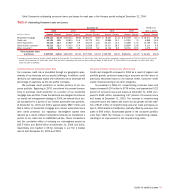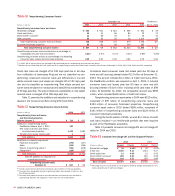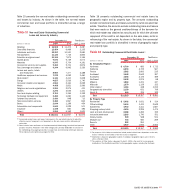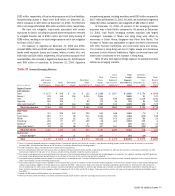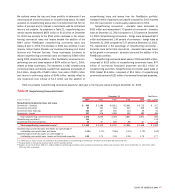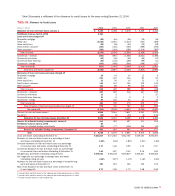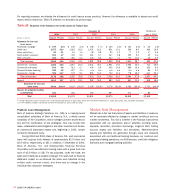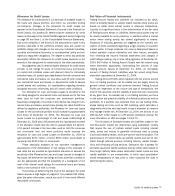Bank of America 2004 Annual Report Download - page 70
Download and view the complete annual report
Please find page 70 of the 2004 Bank of America annual report below. You can navigate through the pages in the report by either clicking on the pages listed below, or by using the keyword search tool below to find specific information within the annual report.
BANK OF AMERICA 2004 69
Provision for Credit Losses
The Provision for Credit Losses was $2.8 billion in 2004, a two percent
decline, despite the addition of the FleetBoston portfolio. The consumer
portion of the Provision for Credit Losses increased to $3.6 billion in
2004 driven by consumer net charge-offs of $2.8 billion. Organic
growth, overall seasoning of credit card accounts, the return of secu-
ritized loans to the balance sheet, and increases in minimum pay-
ment requirements drove higher consumer net charge-offs and
consumer provision. The commercial portion of the Provision for
Credit Losses was a negative $623 million in 2004 with commercial
net charge-offs of $356 million. The commercial provision decreased
due to continued commercial credit quality improvement. The
Provision for Credit Losses included a negative $70 million related to
changes in the general portion of the Allowance for Loan and Lease
Losses due to improved economic conditions. The Provision for Credit
Losses also included a negative $99 million related to changes in the
reserve for unfunded lending commitments due to continued com-
mercial credit quality improvement and improved economic conditions.
We expect that continued seasoning of credit card accounts, the
return of approximately $4.5 billion of securitized loans to the balance
sheet in 2005 and increased minimum payment requirements will
result in higher levels of consumer net charge-offs in 2005.
Commercial net charge-offs may return to more normalized levels dur-
ing 2005. These anticipated increases in net charge-offs, coupled with
less dramatic improvement in commercial credit quality than experi-
enced in 2004, are expected to result in increases in the consumer
and commercial portions of the Provision for Credit Losses in 2005.
Allowance for Credit Losses
Allowance for Loan and Lease Losses
The Allowance for Loan and Lease Losses is allocated based on three
components. We evaluate the adequacy of the Allowance for Loan and
Lease Losses based on the combined total of these three components.
The first component of the Allowance for Loan and Lease
Losses covers those commercial loans that are either nonperforming
or impaired. An allowance is allocated when the discounted cash
flows (or collateral value or observable market price) are lower than
the carrying value of that loan. For purposes of computing the spe-
cific loss component of the allowance, larger impaired loans are eval-
uated individually and smaller impaired loans are evaluated as a pool
using historical loss experience for the respective product type and
risk rating of the loans.
The second component of the Allowance for Loan and Lease
Losses covers performing commercial loans and leases, and consumer
loans. The allowance for commercial loans and leases is established
by product type after analyzing historical loss experience, by internal
risk rating, current economic conditions and performance trends
within each portfolio segment. The commercial historical loss experi-
ence is updated quarterly to incorporate the most recent data reflec-
tive of the current economic environment. As of December 31, 2004,
this resulted in an immaterial decrease to the commercial allowance
for loan losses from updating the historical loss experience. The
allowance for consumer loans is based on aggregated portfolio seg-
ment evaluations, generally by product type. Loss forecast models are
utilized for consumer products that consider a variety of factors includ-
ing, but not limited to, historical loss experience, estimated defaults or
foreclosures based on portfolio trends, delinquencies, economic trends
and credit scores. These consumer loss forecast models are updated
on a quarterly basis in order to incorporate information reflective of the
current economic environment. As of December 31, 2004, this resulted
in an immaterial increase to the allowance for consumer loan and lease
losses from updating the loss forecast models.
The third, or general component of the Allowance for Loan and
Lease Losses is maintained to cover uncertainties that affect our
estimate of probable losses. These uncertainties include the impre-
cision inherent in the forecasting methodologies, as well as domes-
tic and global economic uncertainty and large single name defaults
or event risk. We assess these components, and consider other cur-
rent events, like the Merger, and other conditions, to determine the
overall level of the third component. The relationship of the third com-
ponent to the total Allowance for Loan and Lease Losses may fluctu-
ate from period to period.
We monitor differences between estimated and actual incurred
loan and lease losses. This monitoring process includes periodic
assessments by senior management of loan and lease portfolios and
the models used to estimate incurred losses in those portfolios.
Additions to the Allowance for Loan and Lease Losses are made
by charges to the Provision for Credit Losses. Credit exposures
deemed to be uncollectible are charged against the Allowance for
Loan and Lease Losses. Recoveries of previously charged off
amounts are credited to the Allowance for Loan and Lease Losses.
The Allowance for Loan and Lease Losses for the consumer
portfolio as presented in Table 25 increased $1.3 billion to $3.8 billion
from December 31, 2003 due to the addition of $592 million on April
1, 2004 of FleetBoston allowance for consumer loan and lease
losses, and continued organic growth in consumer loans, primarily
credit card. The Allowance for Loan and Lease Losses on the credit
card portfolio increased $1.2 billion to $2.8 billion driven by the
$466 million addition related to the FleetBoston on-balance sheet
card portfolio on April 1, 2004, organic credit card portfolio growth,
the return of previously securitized credit card balances to the balance
sheet and increases in the minimum payment requirements.


